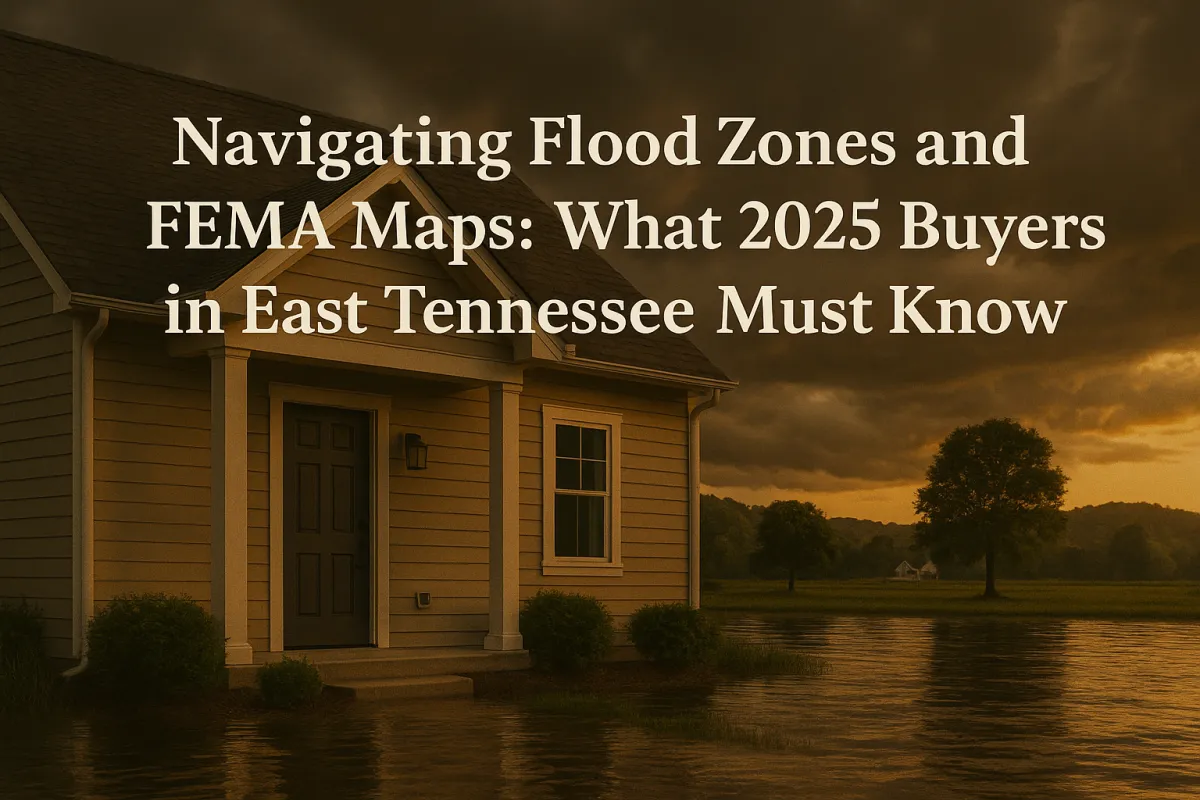
Navigating Flood Zones and FEMA Maps: What 2025 Buyers in East Tennessee Must Know
Navigating Flood Zones and FEMA Maps: What 2025 Buyers in East Tennessee Must Know
Introduction: That Dream Home Might Come With a Surprise… and It Rhymes with "Wade"
Imagine this: You fall in love with a charming cottage near the Tennessee River. It has mountain views, a wraparound porch, and a suspiciously low price. You’re about to make an offer when someone mentions two little words: flood zone.
Cue the record scratch.
Buying a home in East Tennessee comes with all kinds of natural beauty—rolling hills, riverside retreats, mountain views—but also unique challenges like navigating FEMA flood maps, understanding zone classifications, and figuring out if you’ll need flood insurance (hint: you probably will if you skip this blog).
If you’re house hunting in places like Chattanooga Valley, Cleveland, or Athens, TN, understanding flood zones isn’t optional—it’s essential.
In this guide, you’ll learn how FEMA maps work, how to check if a home is in a flood zone, what flood insurance really costs in 2025, and how to protect your investment.
What Is a Flood Zone, and Why Should East Tennessee Buyers Care?
A flood zone is a geographic area defined by FEMA (Federal Emergency Management Agency) that reflects the level of flood risk in that area.
Some zones mean you’re good to go with no required insurance. Others? You might need mandatory flood insurance—and a life jacket.
🔍 Real Talk: East Tennessee’s lush river valleys and heavy seasonal rains mean many homes, even those miles from water, fall into high-risk flood zones.
Understanding FEMA Flood Zone Types
Here’s a quick breakdown of the zones you’re most likely to encounter:
✅ Zone X (Low to Moderate Risk)
Flood insurance not required by lenders
Still recommended, especially in storm-prone areas
⚠️ Zone AE or A (High Risk)
Lenders require flood insurance
Found near rivers, creeks, lakes, or areas with poor drainage
⚡ Zone VE (Coastal High Risk)
Not as common in East Tennessee
Applies more to coastal states—but worth knowing
💡 Did You Know? Over 20% of flood insurance claims come from properties in low- or moderate-risk zones (Zone X). Just because it’s not required doesn’t mean you’re safe.
How to Check Flood Zones in East Tennessee
Step 1: Use FEMA’s Flood Map Tool
Visit msc.fema.gov and enter the address. The tool will show the flood zone, risk level, and the official FEMA map for the area.
Step 2: Cross-Reference with Local Data
Cities like Chattanooga and counties in the East Tennessee region often have more updated or detailed flood risk information than FEMA. Ask your realtor for local resources or contact the planning/zoning office.
Step 3: Review the Seller's Disclosure
In Tennessee, sellers must disclose if a property is in a floodplain or has a history of flooding. Don’t skip this section!
The 2025 Flood Insurance Reality
Thanks to FEMA’s Risk Rating 2.0, flood insurance pricing has changed. Rates are now based on individual property risk—not just flood zones. That means:
Older homes may cost more to insure.
Elevation, foundation type, and distance to water all impact pricing.
On average, flood insurance in East Tennessee ranges from $600 to $1,800 annually, depending on the property.
👉 Expert Tip: Before you fall in love with a property, ask your agent to get a flood quote early—ideally during the option or inspection period.
Local Flooding Hotspots in East Tennessee to Watch
📍 Chattanooga Valley: Areas near South Chickamauga Creek and Lookout Valley often fall in AE zones.
📍 Cleveland, TN: Parts of Candies Creek Ridge and Mouse Creek are historically prone to flash floods.
📍 Athens, TN: Nearby rivers and poor drainage areas make some neighborhoods higher-risk.
📍 Hixson & Soddy-Daisy: Homes near North Chickamauga Creek Trail often sit on the edge of moderate- to high-risk zones.
Off-the-MLS Truths: Why Some Homes “Seem Too Cheap”
If you see a gorgeous home with an oddly low price tag, check the flood zone. Many sellers don’t list the full story on Zillow or Facebook Marketplace. A required $2,000/year flood insurance policy could be the reason for the markdown.
🔍 Pro Insight: Ask for a copy of the seller’s flood elevation certificate—this document can help you get better rates or contest an incorrect FEMA map designation.
Featured Snippet: How to Check If a Home Is in a Flood Zone
How to Check Flood Zones Before Buying in East Tennessee:
Use FEMA’s flood map search at msc.fema.gov
Contact your local zoning/planning office
Ask your realtor for flood zone history
Get a flood insurance quote during due diligence
Review the seller’s property disclosure and elevation certificate
Myths vs. Reality: Flood Edition
❌ Myth: "If it's not near a river, it won't flood."
✅ Reality: Flash floods, poor drainage, or upstream development can flood homes miles from any visible water.
❌ Myth: "New homes don't flood."
✅ Reality: Many new subdivisions are built in former floodplains. Always double-check elevation and history.
Flood Smart Buying Tips for 2025
✅ Ask for an Elevation Certificate
This document could save you hundreds per year in insurance—or help you get a Letter of Map Amendment (LOMA) to remove your property from a high-risk zone.
✅ Factor Insurance Into Monthly Costs
Don’t just look at your mortgage. Insurance can add $50–$200/month to your payment.
✅ Inspect for Past Flood Damage
Even if it’s not disclosed, look for water lines in crawl spaces, sump pumps, or recent foundation repairs.
Conclusion: Be Informed, Not Soaked
East Tennessee is one of the most beautiful and affordable regions in the South—but it pays (literally) to be smart about flood risk. Whether you’re buying in Chattanooga Valley or a quiet North GA border town, understanding FEMA maps, insurance costs, and local risk factors could save your investment—and your sanity.
🏡 Ready to find a home that fits your budget, lifestyle, and your flood risk comfort level? Let’s chat. I’ll help you navigate the maps, the myths, and the market. Click here!
